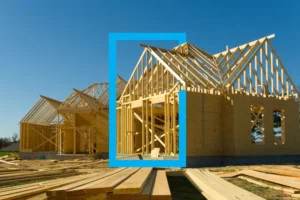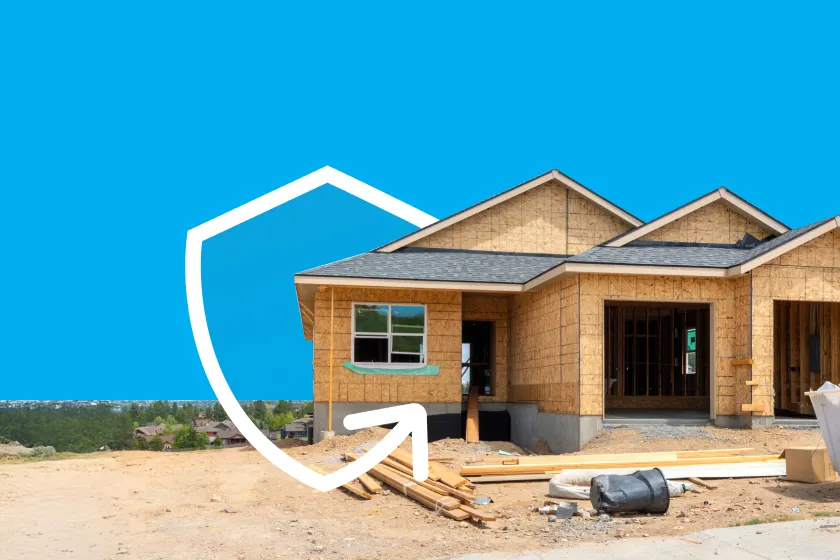You have signed the papers, picked up the keys, and stepped into your brand-new home. Everything feels just right until trouble sneaks in. A new construction home warranty might be the only thing standing between you and a major repair bill. Because cracks, leaks, and faulty installations don’t care how new your house is.
Builders aren’t perfect. Systems fail. And once the excitement fades, issues that didn’t show up during inspection might surprise you.
Think it’s too early to worry? Think again. The fine print in your warranty might determine who pays when the ceiling drips or the floor shifts.
This blog walks you through the real deal behind builder warranties: what’s in, what’s not, and how to actually get support when you need it.
Table of contents
-
-
- What is a New Construction Home Warranty?
- Is a builder’s warranty the same as a home warranty?
- How Do New Construction Warranties Benefit Homebuyers?
- The Standard 10-Year Warranty Structure for Home Builders
- How long should a builder’s home warranty last?
- Are Builders Legally Required to Provide a Home Warranty?
- What Does a Builder’s Warranty Cover?
- What isn’t covered in a home builder’s warranty?
- How to Make a Warranty Claim?
- The Bottom Line: Locking In Long-Term Peace of Mind
- Frequently Asked Questions
-
What is a New Construction Home Warranty?
A new construction home warranty, also known as a homebuilder’s warranty, is essentially a builder-backed insurance agreement. It covers the core structure and essential systems of your newly built home. These include foundation, plumbing, electrical, roofing, and other key components that are built to withstand everyday use.
The builder holds the actual policy, but as the homeowner, you are the one who benefits if something goes wrong. It’s a way of your builder saying, “We stand by our work.” in writing.
Warranty coverage and terms can vary depending on where you live, so it’s worth reading the details carefully before you sign. Knowing what is protected and what is excluded isn’t just a detail, but saves you from a lot of confusion later.
Quick heads-up! This is something many homeowners ask:
Is a builder’s warranty the same as a home warranty?
Not really! A builder’s warranty is typically included with the purchase of a newly constructed home, covering structural defects and workmanship issues. On the other hand, a home warranty is a separate service contract that you can purchase to cover appliances and home systems.
How Do New Construction Warranties Benefit Homebuyers?
Newly built homes come with the promise of brand-new everything, from walls to wiring, plumbing to electrical systems, and more. Most homeowners expect little to no issues after moving in. Still, even new builds aren’t immune to defects or oversights.
Having a new construction home warranty offers that extra layer of protection so you are covered if things don’t go as planned. Let’s see what benefits it offers:
Worry-Free Living from the Start

Knowing a builder-backed warranty is in place takes a huge weight off your shoulders the moment you step into your new house. It means that if something essential fails early on, the repair bill goes to the builder, not you. With that guarantee in writing, you can unpack boxes without wondering when the first costly glitch might strike.
Coverage From Foundation to Fixtures
Most builder warranties cover the big stuff, foundation, framing, roof, and many stretch to include key systems. Wiring shorts out or a line leaks? It is addressed at no extra cost. That top-to-bottom safety net keeps your savings intact on early-life hiccups while every part of the house settles into place.
Shielding Your Wallet from Big Repairs
New homes built with advanced techniques and modern building materials promise durability, but they are still mechanical parts that are subject to failures. When the HVAC system fails in the middle of summer or a plumbing line bursts behind the wall, the repair bill can climb fast.
Having a home coverage plan picks up that cost, saving you thousands of dollars. It replaces stress calls with a simple service request, and the issue is fixed by the builder.
Fewer Things To Worry About in The First Year
The first year in any new place is busy enough. Your calendar is full with to-do lists like unpacking, landscaping, maybe wrangling a housewarming party. If the HVAC fan quits or a faucet leaks, a builder warranty spares you the hassle of tracking down a repair tech.
Submit a claim online, and the builder lines up the repair crew. This way, you stay focused on nesting, not negotiating quotes or waiting on hold with service companies.
Long-Term Value Add
That transferable 10-year structural warranty doesn’t just protect you; it’s a selling feature that buyers notice. Knowing major components remain covered can nudge negotiations in your favor and maybe even speed up the sale.
Although the one-year workmanship coverage stays with the original owner, the structural warranty continues to offer protection long after the keys change hands.
Fills the Insurance Gaps
Homeowners’ insurance policies handle disasters like fires or storms, but they ignore the mundane failures that actually happen more often. The builder warranty picks up those bills for worn seals, squeaky motors, and leaky valves. It shoulders the everyday mechanical repairs insurance won’t touch, sparing you surprise invoices and late-night Googling for service techs.
The Standard 10-Year Warranty Structure for Home Builders
Builder warranties for new homes are typically structured in phases and follow a clear timeline. Quick cosmetic fixes up front, mechanical coverage over the next couple of years, and structural protection for up to ten years.
These warranties may be serviced by the builder directly or through a separate third-party provider. So it’s important to understand who is responsible and when.
Workmanship & Building Materials – Year 1
For the first twelve months, your warranty covers surface imperfections born of construction: chipped paint, mis-set tiles, sticking windows, or squeaky hinges. If the imperfection ties back to craftsmanship, the builder corrects it. Record each issue during inspections, ensuring corrections are scheduled before the twelve-month service period reaches its closing date.
System Reliability– Years 1 and 2
Coverage then turns to essential systems: HVAC, electrical wiring, and plumbing. These components run around the clock, so failure costs mount quickly. The warranty absorbs those early-life repairs, letting you handle utility bills and furnishings instead of surprise service charges before they drain savings.
Structural Assurance – Up to 10 Years

The final tier focuses on the structure itself, covering load-bearing walls, slabs, footings, and roof framework for as long as ten years. Should settlement or shear forces cause cracking or warping, the warranty provides a remedy. Extended structural protection safeguards equity by preventing catastrophic repair bills from landing on owners during the property’s early stabilization period.
Many builders ask this question related to their tenure:
How long should a builder’s home warranty last?
The answer often goes beyond legal requirements. While states vary in what’s mandated, offering a decade-long warranty through a trusted provider is a smart decision.
It shows buyers you are confident in your work. Buying a new home is exciting, but it also comes with its own set of worries. A 10-year warranty on new construction signals quality and reassures buyers that they’re not alone if a major issue pops up.
Are Builders Legally Required to Provide a Warranty?
No, builders aren’t always required by law to offer a home warranty for new construction, though some states have rules or optional programs in place. While many do provide warranties, not all states make it mandatory.
At the federal level, there is no law forcing builders to include warranties.
Laws differ by state; some require warranties, others don’t. Builders often must take responsibility for defects in materials, workmanship, and systems for a limited time, even if there’s no legal requirement.
Local laws set the details: how long warranties last, what’s covered, and how disputes are handled.
What Does a Builder’s Warranty Cover?
Usually, builder warranties cover a range of materials and craftsmanship used during construction. These often include:
-
-
- Concrete floors and foundations
- Plumbing systemsRoofing and shingles
- Electrical wiring and components
- Heating and cooling systems
- Doors and windows
- Carpentry
- Garage doors
- Insulation
- Glass installations
- Septic systems
- Waterproofing
- Dry basements
- Landscaping
- Thermal and moisture barriers
-
What isn’t covered in a home builder’s warranty?
It can be disappointing to find out that certain issues aren’t covered under your new construction home warranty. Doing thorough inspections and walkthroughs before, during, and after construction can help clarify what’s on the builder’s plate and what isn’t.
Generally, weather damage and normal wear and tear aren’t part of the warranty. Some common exclusions include:
-
-
- Household appliances
- Damage caused by homeowner modifications or third-party work done after construction
- Shrinking and expanding of the home structure
- Minor cracks and joint shrinkage
- Fading paint over time
- Moisture or condensation due to poor ventilation
- Insect infestations
-
For protection beyond what a builder’s warranty includes, you can choose our home warranty plans that offer coverage for the most-used home systems and appliances.
Whether it’s a faulty dishwasher or an unexpected electrical issue, we help protect your budget from expensive repair bills. Since homeownership comes with surprises, stay prepared and safeguard your investment with dependable coverage.
How to Make a Warranty Claim?
If you spot an issue you believe falls under your builder warranty, you need to follow the steps below:
-
-
- Step 1: Check coverage first – Dig out the service contract or policy agreement to be sure the issue qualifies and that the coverage period hasn’t expired.
- Step 2: File Your Claim – Follow the warranty’s claim instructions, then back them up with a written claim outlining the defect and requesting repairs.
-
Pro Tip: Keep all correspondence and phone records so you can quickly provide proof of your communications if needed.
The Bottom Line: Locking In Long-Term Peace of Mind
A new home represents a fresh start, but it doesn’t mean issues won’t crop up, which is why you need a new construction home warranty. It’s reassurance that the home you have invested in is backed by real support.
Offering or asking for a solid builder’s warranty is not just about compliance or fine print. It is a clear signal of confidence in the craftsmanship and a reliable safety shield for the homeowner.
With different coverage timelines for workmanship, systems, and structural elements, a builder’s warranty provides clear protection across the board. It helps make sure the excitement of moving in isn’t overshadowed by an unexpected repair bill.
Have questions? Select Home Warranty’s support team can walk you through plan options, pricing, and add-ons that fit your budget. Contact us to discover how easy it is to manage future maintenance needs.
Frequently Asked Questions
-
-
- How much does a new construction home warranty cost?
Typically, a 10-year builder’s warranty adds up to less than half a percent of your home’s total price, land included. However, prices can vary by state, often based on factors such as soil stability and regional construction risks. - When does coverage typically begin?In most cases, there’s a 30-day waiting period before your coverage kicks in. This window is in place to help prevent claims on issues that existed before the plan was purchased, which helps keep costs fair for all warranty holders. Once the 30 days pass, you can start using your coverage for eligible repairs.
- How does a home builder’s warranty typically work?
- How much does a new construction home warranty cost?
-
A warranty provides direct support from your builder or through a builder-backed third-party provider. If something goes wrong, you can report the issue, often with photos or videos, through a digital system. Urgent problems get quick attention, while less pressing ones are scheduled at your convenience.
Disclaimer: The information in this article is intended to provide guidance on the proper maintenance and care of systems and appliances in the home. Not all the topics mentioned are covered by our home warranty plans. Please review your home warranty contract carefully to understand your coverage.
Our blogs and articles may link to third-party sites that offer products, services, coaches, consultants, and/or experts. Any such link is provided for reference only and not intended as an endorsement or statement that the information provided by the other party is accurate. We are not compensated for any products or services purchased from these third-party links.

